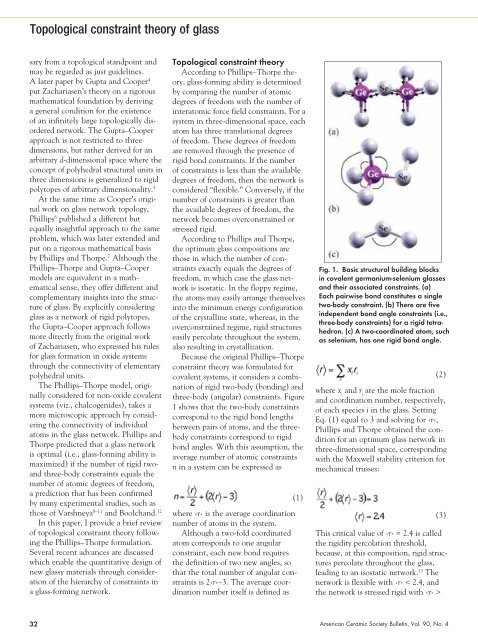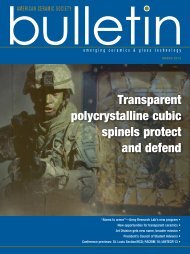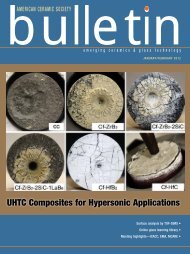American Ceramic Society Bulletin
American Ceramic Society Bulletin
American Ceramic Society Bulletin
You also want an ePaper? Increase the reach of your titles
YUMPU automatically turns print PDFs into web optimized ePapers that Google loves.
Topological constraint theory of glass<br />
sary from a topological standpoint and<br />
may be regarded as just guidelines.<br />
A later paper by Gupta and Cooper 4<br />
put Zachariasen’s theory on a rigorous<br />
mathematical foundation by deriving<br />
a general condition for the existence<br />
of an infinitely large topologically disordered<br />
network. The Gupta–Cooper<br />
approach is not restricted to three<br />
dimensions, but rather derived for an<br />
arbitrary d-dimensional space where the<br />
concept of polyhedral structural units in<br />
three dimensions is generalized to rigid<br />
polytopes of arbitrary dimensionality. 5<br />
At the same time as Cooper’s original<br />
work on glass network topology,<br />
Phillips 6 published a different but<br />
equally insightful approach to the same<br />
problem, which was later extended and<br />
put on a rigorous mathematical basis<br />
by Phillips and Thorpe. 7 Although the<br />
Phillips–Thorpe and Gupta–Cooper<br />
models are equivalent in a mathematical<br />
sense, they offer different and<br />
complementary insights into the structure<br />
of glass. By explicitly considering<br />
glass as a network of rigid polytopes,<br />
the Gupta–Cooper approach follows<br />
more directly from the original work<br />
of Zachariasen, who expressed his rules<br />
for glass formation in oxide systems<br />
through the connectivity of elementary<br />
polyhedral units.<br />
The Phillips–Thorpe model, originally<br />
considered for non-oxide covalent<br />
systems (viz., chalcogenides), takes a<br />
more microscopic approach by considering<br />
the connectivity of individual<br />
atoms in the glass network. Phillips and<br />
Thorpe predicted that a glass network<br />
is optimal (i.e., glass-forming ability is<br />
maximized) if the number of rigid two-<br />
and three-body constraints equals the<br />
number of atomic degrees of freedom,<br />
a prediction that has been confirmed<br />
by many experimental studies, such as<br />
those of Varshneya 8–11 and Boolchand. 12<br />
In this paper, I provide a brief review<br />
of topological constraint theory following<br />
the Phillips–Thorpe formulation.<br />
Several recent advances are discussed<br />
which enable the quantitative design of<br />
new glassy materials through consideration<br />
of the hierarchy of constraints in<br />
a glass-forming network.<br />
Topological constraint theory<br />
According to Phillips–Thorpe theory,<br />
glass-forming ability is determined<br />
by comparing the number of atomic<br />
degrees of freedom with the number of<br />
interatomic force field constraints. For a<br />
system in three-dimensional space, each<br />
atom has three translational degrees<br />
of freedom. These degrees of freedom<br />
are removed through the presence of<br />
rigid bond constraints. If the number<br />
of constraints is less than the available<br />
degrees of freedom, then the network is<br />
considered “flexible.” Conversely, if the<br />
number of constraints is greater than<br />
the available degrees of freedom, the<br />
network becomes overconstrained or<br />
stressed rigid.<br />
According to Phillips and Thorpe,<br />
the optimum glass compositions are<br />
those in which the number of constraints<br />
exactly equals the degrees of<br />
freedom, in which case the glass network<br />
is isostatic. In the floppy regime,<br />
the atoms may easily arrange themselves<br />
into the minimum energy configuration<br />
of the crystalline state, whereas, in the<br />
overconstrained regime, rigid structures<br />
easily percolate throughout the system,<br />
also resulting in crystallization.<br />
Because the original Phillips–Thorpe<br />
constraint theory was formulated for<br />
covalent systems, it considers a combination<br />
of rigid two-body (bonding) and<br />
three-body (angular) constraints. Figure<br />
1 shows that the two-body constraints<br />
correspond to the rigid bond lengths<br />
between pairs of atoms, and the threebody<br />
constraints correspond to rigid<br />
bond angles. With this assumption, the<br />
average number of atomic constraints<br />
n in a system can be expressed as<br />
where ‹r› is the average coordination<br />
number of atoms in the system.<br />
Although a two-fold coordinated<br />
atom corresponds to one angular<br />
constraint, each new bond requires<br />
the definition of two new angles, so<br />
that the total number of angular constraints<br />
is 2‹r›–3. The average coordination<br />
number itself is defined as<br />
32 <strong>American</strong> <strong>Ceramic</strong> <strong>Society</strong> <strong>Bulletin</strong>, Vol. 90, No. 4<br />
(1)<br />
Fig. 1. Basic structural building blocks<br />
in covalent germanium-selenium glasses<br />
and their associated constraints. (a)<br />
Each pairwise bond constitutes a single<br />
two-body constraint. (b) There are five<br />
independent bond angle constraints (i.e.,<br />
three-body constraints) for a rigid tetrahedron.<br />
(c) A two-coordinated atom, such<br />
as selenium, has one rigid bond angle.<br />
(2)<br />
where x i and r i are the mole fraction<br />
and coordination number, respectively,<br />
of each species i in the glass. Setting<br />
Eq. (1) equal to 3 and solving for ‹r›,<br />
Phillips and Thorpe obtained the condition<br />
for an optimum glass network in<br />
three-dimensional space, corresponding<br />
with the Maxwell stability criterion for<br />
mechanical trusses:<br />
(3)<br />
This critical value of ‹r› = 2.4 is called<br />
the rigidity percolation threshold,<br />
because, at this composition, rigid structures<br />
percolate throughout the glass,<br />
leading to an isostatic network. 13 The<br />
network is flexible with ‹r› < 2.4, and<br />
the network is stressed rigid with ‹r› >






